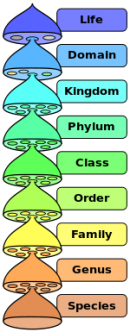Taxonomy of Canivora
Every living organisms are classified in different groups, named a taxonomic classification. The organisms are subdivided in life, domain, kingdom, phylum, class, order, family, genus and species (figure 5). In the main groups there could also be some sub-groups, for example a subphylum. The animals that share most of their DNA (and/or characteristics) are classified in the same taxonomic group upon the last common ancestor (Hickman, Roberts, Keen, Larson, & Eisenhour, 2009). Life is first separated in three different domains, these are Bacteria, Archaea and Eukaryota. The group Animals are one of the kingdoms in the domain of Eukaryota. The kingdom of Animals is divided in different phylum’s, one of them is the group of Chordata. The subphylum Vertebrata comes out of the phylum Chordata. Vertebrata is separated in seven different classes, one of them is the order Mammalia. This is further classified in three subclasses. The subclasses are Ornithodelphia, Metheria and Eutheria. Eutheria exist of several different orders. One of the orders is Carnivora. (Hickman, Roberts, Keen, Larson, & Eisenhour, 2009). The Ursidae and the Felidae families out the order Carnivora are futher explained is this research. Also the order Primates out of the subclass Eutheria is further explained in this research. Figure 6 shows an overview of the taxonomy of the mammals.

FIGURE 5 The taxonomic classification subdivided in life, domain, kingdom, phylum, class, order, family, genus and species

FIGURE 6 An overview of the taxonomy of the mammals. The red lines indicates the taxonomy of the animals that are further explained in this research (Primates, Ursidae, Felidae).